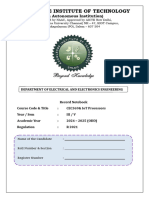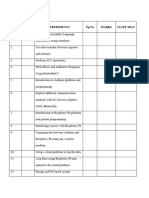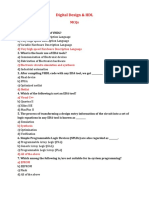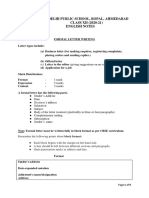Online MachineLearningUsing Python
Uploaded by
Debasis ChandraOnline MachineLearningUsing Python
Uploaded by
Debasis ChandraCourse code Machine Learning with Python L T P J C
2 0 2 0 3
Pre-requisite Nil Syllabus Version
Course Objectives:
This course introduces the basics of machine learning using an approachable and well-known
programming language, Python. It covers a broad set of operations including preparing and analyzing
the datasets, segregating into training and testing, selecting appropriate models based on data, training
the data by varying hyperparameters to achieve better results and to visualize the results for preferable
understanding.
Course Outcome:
By the end of the course the students will be able to,
1. Analyze, pre-process, classify the dataset and select appropriate algorithm for training the
model.
2. Train the machine learning model using chosen algorithm to predict/classify/cluster and
produce information.
3. Able to ensemble multiple models in case of requirement for better results.
4. Choose appropriate metrics to check validity of trained models and create visualizations for
better presentation.
Student Learning Outcomes(SLO):
2. Having a clear understanding of the subject related concepts and of contemporary issues
5. Having design thinking capability
7. Having computational thinking (Ability to translate vast data in to abstract concepts and to
understand database reasoning)
9. Having problem solving ability- solving social issues and engineering problems
Module Topics Hours CO
1. Introduction to Machine Learning & Python 6 1
Machine Learning – Introduction & applications – Learning Paradigms
-Creating Environment (Python & Anaconda) – Introduction to NumPy,
Pandas, SKlearn, pyplot, seaborn packages – Reading data files into
Memory - Visualization
2. Data Preprocessing 5 1
Understanding datasets – Spitting datasets to training & testing - Data
cleaning – Normalization – Correlation Analysis – Feature Selection –
Feature Reduction – Learning curves – Cross validation - Machine
Learning model
3. Supervised Learning – I (Regression) 6 1,2,4
Introduction – Linearity & Non-linearity - Linear Regression – Multi-
Linear Regression – Gradient Descent – Evaluation of Model – Metrics
supported – Implementation of Multi-Linear Regression – Variance-Bias
tradeoff
4. Supervised Learning – II (Classification) 8 1,2,4
Introduction – Logistic Regression – Naïve Bayes – Decision trees – KNN
classification – Perceptron (Theory, Implementation & evaluation) –
Hyperparameters – Confusion matrix – F1 score – Visualization
5. Support Vector Machines 3 1,2,4
Introduction – Linear & Non-linear SVM – Kernel – Designing customized
kernels – Hyperparameters
6. Unsupervised Learning (Clustering) 5 1,2,4
Elaboration – Partition based – Hierarchical – Density based - K-Means –
KNN – K-Mode – K-Medoid – Evaluation metrics
7. Ensemble Learning 5 3,4
Introduction – Possibilities - Bagging – Boosting – Adaboost, XGBoost –
Random Forest – Evaluation
8. Essentials 2 1,2,3,4
Repositories – Online resources – Execution platforms – Selection of
algorithms - PCA
Total Hours 40
Teaching Pedagogy:
Online Learning materials, Video Lectures and Case studies
Evaluation Criterion: Online Quiz, Digital Assignment, Case Study Analysis Report and Term End
Examination
Reference Materials:
1. Tom Mitchell, “Machine Learning”, McGraw Hill, 3rd Edition,1997.
2. Ethem Alpaydin , " Introduction to Machine Learning ” , MIT Press, Prentice Hall of India,
Third Edition 2014.
3. Manaranjan Pradhan, U Dinesh Kumar, “Machine Learning using Python”, Wiley Publications,
2019.
You might also like
- Linear Integrated Circuits - S. Salivahanan and v. S. K. BhaaskaranNo ratings yetLinear Integrated Circuits - S. Salivahanan and v. S. K. Bhaaskaran79 pages
- Low Cost' Three Phase To Single Phase Matrix ConverterNo ratings yetLow Cost' Three Phase To Single Phase Matrix Converter6 pages
- Mechatronics and Robotics Engineering: UndergraduateNo ratings yetMechatronics and Robotics Engineering: Undergraduate2 pages
- IAT-I Question Paper With Solution of 18CS71 Artificial Intelligence and Machine Learning Oct-2022-Dr. Paras Nath SinghNo ratings yetIAT-I Question Paper With Solution of 18CS71 Artificial Intelligence and Machine Learning Oct-2022-Dr. Paras Nath Singh7 pages
- Jump, Loop and Call Instructions: University of Engineering and Technology TaxilaNo ratings yetJump, Loop and Call Instructions: University of Engineering and Technology Taxila93 pages
- Robotics and Machine Vision Internal 3 Important QuestionsNo ratings yetRobotics and Machine Vision Internal 3 Important Questions1 page
- CS3491 - Notes - Unit 4 - Ensemble Techniques and Unsupervised LearningNo ratings yetCS3491 - Notes - Unit 4 - Ensemble Techniques and Unsupervised Learning35 pages
- Micromachining - Seminar Reports - PPT - PDF - DOC - Presentation - Free Download For Mechanical Engineering100% (1)Micromachining - Seminar Reports - PPT - PDF - DOC - Presentation - Free Download For Mechanical Engineering3 pages
- PIC Microcontroller and Embedded Systems Muhammad Ali Mazidi, Rolin McKinlay and Danny CauseyNo ratings yetPIC Microcontroller and Embedded Systems Muhammad Ali Mazidi, Rolin McKinlay and Danny Causey10 pages
- 5 Unit5 Arduino Interrupt, Timer and CommunicationNo ratings yet5 Unit5 Arduino Interrupt, Timer and Communication19 pages
- Slide 2 ARM Architecture and Instruction SetNo ratings yetSlide 2 ARM Architecture and Instruction Set234 pages
- TensorFlow Lite Micro Embedded Machine LNo ratings yetTensorFlow Lite Micro Embedded Machine L13 pages
- Reconfigurable Hardware Design Approach For Economic Neural NetworkNo ratings yetReconfigurable Hardware Design Approach For Economic Neural Network5 pages
- 22ee009 Modern Rectifiers and Resonant ConvertersNo ratings yet22ee009 Modern Rectifiers and Resonant Converters3 pages
- Line Follower Robot Using 8051 Micro Controller100% (3)Line Follower Robot Using 8051 Micro Controller34 pages
- GATE-1999 One Mark Questions: Institute of Engineering Studies (IES, Bangalore) Analog Electronics Old GATE ECE100% (2)GATE-1999 One Mark Questions: Institute of Engineering Studies (IES, Bangalore) Analog Electronics Old GATE ECE74 pages
- WINSEM2020-21 ECE3502 ETH VL2020210501414 REFERENCE MATERIAL Internet of Things-2 SyllabusNo ratings yetWINSEM2020-21 ECE3502 ETH VL2020210501414 REFERENCE MATERIAL Internet of Things-2 Syllabus3 pages
- GK DUBEY SOLUTIONS OF ELECTRIC DRIVE - in This Site Isn't The Same AsNo ratings yetGK DUBEY SOLUTIONS OF ELECTRIC DRIVE - in This Site Isn't The Same As1 page
- Cs3691 Embedded Systems and Iot Laboratory Record..No ratings yetCs3691 Embedded Systems and Iot Laboratory Record..50 pages
- ELL 740 Compact Modeling of Semiconductor Devices: Dr. Abhisek DixitNo ratings yetELL 740 Compact Modeling of Semiconductor Devices: Dr. Abhisek Dixit45 pages
- Application-Specific Integrated Circuit ASIC A Complete GuideFrom EverandApplication-Specific Integrated Circuit ASIC A Complete GuideNo ratings yet
- Connectivity Prediction in Mobile Ad Hoc Networks for Real-Time ControlFrom EverandConnectivity Prediction in Mobile Ad Hoc Networks for Real-Time Control5/5 (1)
- Rhetorical Questions For Debate and Speech: Delhi Public School, Bopal, Ahmedabad CLASS XII (2020-21) English NotesNo ratings yetRhetorical Questions For Debate and Speech: Delhi Public School, Bopal, Ahmedabad CLASS XII (2020-21) English Notes2 pages
- Note Making: Delhi Public School, Bopal, Ahmedabad CLASS XII (2020-21) English NotesNo ratings yetNote Making: Delhi Public School, Bopal, Ahmedabad CLASS XII (2020-21) English Notes4 pages
- Delhi Public School, Bopal, Ahmedabad CLASS XII (2020-21) English NotesNo ratings yetDelhi Public School, Bopal, Ahmedabad CLASS XII (2020-21) English Notes9 pages
- Top 20 Chemical Engineering Colleges in India 2016No ratings yetTop 20 Chemical Engineering Colleges in India 20161 page
- School of Electronics Engineering (SENSE)No ratings yetSchool of Electronics Engineering (SENSE)7 pages
- Delhi Public School, Bopal, Ahmedabad CLASS XII (2020-21) English NotesNo ratings yetDelhi Public School, Bopal, Ahmedabad CLASS XII (2020-21) English Notes5 pages
- Delhi Public School - Bopal, Ahmedabad Half Yearly Examination 2020-21 Class: Xii Syllabus & Blue PrintNo ratings yetDelhi Public School - Bopal, Ahmedabad Half Yearly Examination 2020-21 Class: Xii Syllabus & Blue Print8 pages
- SL No. Subjects CH No Chapters Weightage Section A-Reading 20No ratings yetSL No. Subjects CH No Chapters Weightage Section A-Reading 204 pages
- Programming Assignment 4: Divide-and-ConquerNo ratings yetProgramming Assignment 4: Divide-and-Conquer13 pages
- Predicting The Admissions of Students in Masters Program Using Machine LearningNo ratings yetPredicting The Admissions of Students in Masters Program Using Machine Learning16 pages
- Exponential Smoothing Forecasting Method PDFNo ratings yetExponential Smoothing Forecasting Method PDF2 pages
- An Evaluation of A Simple Model For Predicting Surgery - 2021 - Informatics inNo ratings yetAn Evaluation of A Simple Model For Predicting Surgery - 2021 - Informatics in10 pages
- Fuzzy Logic Controller Design and Implementation For Industrial ApplicationsNo ratings yetFuzzy Logic Controller Design and Implementation For Industrial Applications6 pages
- DEEP LEARNING IIT Kharagpur Assignment - 5 - 2024No ratings yetDEEP LEARNING IIT Kharagpur Assignment - 5 - 20249 pages
- Download Complete Analysis of Chaotic Behavior in Non-linear Dynamical Systems Michał Piórek PDF for All Chapters100% (3)Download Complete Analysis of Chaotic Behavior in Non-linear Dynamical Systems Michał Piórek PDF for All Chapters55 pages
- M.E. (Full Time) Computer Science and Engineering: Anna University Chennai-25. Syllabus ForNo ratings yetM.E. (Full Time) Computer Science and Engineering: Anna University Chennai-25. Syllabus For33 pages
- Financial Applications of Random MatrixNo ratings yetFinancial Applications of Random Matrix18 pages
- II-Sem-Module-2-Vector Calculus - 2023 - NotesNo ratings yetII-Sem-Module-2-Vector Calculus - 2023 - Notes52 pages






































































































